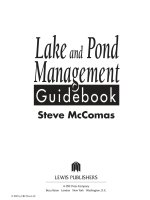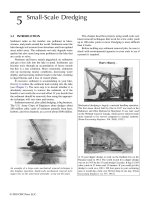Business and society ethics sustainability and stakeholder management 9e chapter 4
Bạn đang xem bản rút gọn của tài liệu. Xem và tải ngay bản đầy đủ của tài liệu tại đây (1.53 MB, 33 trang )
© 2015 Cengage Learning
1
Chapter 4
Corporate
Governance:
Foundational
Issues
© 2015 Cengage Learning
2
Learning Outcomes
1. Link the issue of legitimacy to corporate governance.
2. Identify the best practices boards of directors can follow.
3. Discuss the problems that have led to the recent spate of
corporate scandals and the efforts that are currently underway to
keep them from happening again.
4. Discuss the principle ways in which shareholder activism exerted
pressure on corporate management groups to improve
governance.
5. Discuss the ways in which managers relate to shareholders and
the issues arising from that relationship.
6. Compare and contrast the shareholder-primacy and directorprimacy models of corporate governance. What are their
respective strengths and weaknesses? Which do you prefer and
why?
© 2015 Cengage Learning
3
Chapter Outline
• Legitimacy and Corporate Governance
• Problems in Corporate Governance
• Improving Corporate Governance
• The Role of Shareholders
• The Role of the SEC
• Shareholder Activism
• Investor Relations
• An Alternative Model of Corporate Governance
• Summary
© 2015 Cengage Learning
4
Legitimacy
and Corporate Governance
Legitimacy •A condition that prevails when there is a
congruence between an organization’s
activities and society’s expectations.
Legitimation •A dynamic process by which a business seeks
to perpetuate its acceptance.
© 2015 Cengage Learning
5
Legitimacy
© 2015 Cengage Learning
6
Corporate Governance • Refers to the method by which a firm is
being governed, directed, administered, or
controlled, and to the goals for which it is
being governed.
• Is concerned with the relative roles, rights,
and accountability of such stakeholder
groups as owners, boards of directors,
managers, employees, and other
stakeholders.
© 2015 Cengage Learning
7
Roles of Four Major Groups Shareholders •
Own stock in the firm, giving them ultimate
control (the shareholder-primacy model).
Board of Directors •
Govern and oversee management of the
business.
Managers •
The individuals hired by the Board to manage
the business on a daily basis.
Employees •
Hired to perform actual operational work
© 2015 Cengage Learning
8
The Corporation’s
Hierarchy of Authority
State Charter
Shareholders
Board of Directors
Management
Employees
© 2015 Cengage Learning
9
Separation of Ownership from Control
Contributes to Governance Problems
Corporate Period
Precorporate Period
Shareholders
Shareholders
(ownership)
(ownership)
Owners
Owners
(ownership)
(ownership)
Board
Boardof
of
Directors
Directors
Managers
Managers
(control)
(control)
Management
Management
(control)
(control)
© 2015 Cengage Learning
10
The Need for Board Independence
Outside directors –
•are independent from the firm
Inside directors –
•have some tie to the firm
Board independence from management is crucial
to good governance.
© 2015 Cengage Learning
11
Issues Surrounding Compensation
Excessive CEO Pay
Outside Director Compensation
© 2015 Cengage Learning
12
CEO PayFirm Performance Relationship
Stock Options -
•Allows the recipient to purchase stock in the future
at the price it is today.
Backdating -
•Allows the recipient to purchase stock at yesterday’s
price, resulting in immediate wealth increase.
Spring-Loading -
•Granting of a stock option at today’s price, but with
the inside knowledge that stock’s value is improving.
Bullet Dodging -
•Delaying of a stock option grant until right after bad
news.
© 2015 Cengage Learning
13
Excessive CEO Pay
Ratio of CEO pay to that of average worker •1980, 42-1
•2000, 531-1
•2011, 380 to 1
Say on Pay
•Evolved from concerns over excessive
executive compensation.
Clawback provisions
•Compensation recovery mechanisms that
enable a company to recoup CEO pay,
typically in the event of a financial
restatement or executive’s misbehavior.
© 2015 Cengage Learning
14
CEO Pay Controversy
1. Shareholder push to link pay to
performance
Say on Pay
Movement
2. Increasing use of “clawback”
provisions
provisions where executives
must return pay under
under some
some
conditions
© 2015 Cengage Learning
15
Executive Retirement Plans and
Exit Packages
Retirement packages –
•have come under scrutiny.
•
•
$210 million to Robert Nardelli when he
was ousted from Home Depot.
$125 million to outgoing Bank of America
CEO, Ken Lewis
•In contrast, many of today’s workers do not
have a retirement plan.
•Those who do generally have a defined
contribution plan, rather than a defined
benefit plan.
© 2015 Cengage Learning
16
Outside Director Compensation • Paying board members is a recent idea.
• Today, outside board members are paid.
• From 2003-2010, their median pay rose
about a third, from $175,800 to $233,800.
• Controversy over whether directors should
be paid at all, and whether they are paid
enough.
© 2015 Cengage Learning
17
Transparency Exec compensation packages may include deferred pay,
Severance, pension benefits, & other perks over $10,000.
SEC Rules require disclosure of executive compensation
Such disclosures may have a moderating impact
prior to implementation.
© 2015 Cengage Learning
18
Governance Impact of the Market
for Corporate Control
Mergers and acquisitions -
•Expectation is that the threat of a possible
takeover will motivate top managers to pursue
shareholder, rather than self-interest.
•But many corporate CEOs and boards go to
great lengths to protect themselves from
takeovers, using:
• poison pills (discourages a hostile takeover
by making the firm difficult to take on)
• golden parachutes (firm agrees to pay key
officers in the event of a change in control of
the corporation)
© 2015 Cengage Learning
19
Insider Trading •
•
•
•
•
•
The practice of buying or selling a security by
someone who has access to material information
that is not available to the public.
“Material Information” is information that a
reasonable investor might want to use, and is
likely to affect the price of the firm’s stock.
A “tipper” provides that information
A “tippee” receives the information
Executives and others who work for a firm may
have inside information
Also those in relationships that include a duty of
confidentiality may have inside information,
including spouses, parents, children, friends.
© 2015 Cengage Learning
20
Improving Corporate Governance (1 of 2)
• Sarbanes-Oxley Act of 2002 (SOX) • Amends securities laws to protect investors in
public companies
• Enhances public disclosure to require reporting
of off-balance sheet transactions, and personal
loans to executives
• Limits the nonauditing services an auditor can
provide to a firm it audits
• Makes it unlawful for accounting firms to provide
services where conflicts of interests exist
• CEOs and CFOs must certify financials, and are
held responsible for financial representations
© 2015 Cengage Learning
21
Improving Corporate Governance (2 of 2)
Changes in boards of directors • More Board diversity
• A greater ratio of outside board members
to inside board members
•Use of board committees to:
• Ensure that financials are not misleading
• Ensure that internal controls are adequate
• Follow-up allegations of irregularities
• Ratify the selection of an external auditor
© 2015 Cengage Learning
22
Red Flags Signaling Board Problems
Ranking of Red Flags1. Company has to restate earnings.
2. Poor employee morale.
3. Negative risk assessment from auditor.
4. Poor customer satisfaction track record.
5. Management misses strategic performance goals.
6. Company is target of employee lawsuits.
7. Stock price declines.
8. Quarterly financial results miss analysts’ expectations.
9. Low corporate governance quotient rating.
© 2015 Cengage Learning
23
Steps to Take for Board Repair
Steps to Take 1.Spread risk oversight among multiple committees
2.Seek outside help in identifying potential risks
3.Deepen involvement in corporate strategy
4.Align board size and skill mix with strategy
5.Revamp executive compensation
6.Pick compensation committee members who will
question the status quo
7.Use independent compensation consultants
8.Evaluate CEO on grooming potential successors
9.Know what matters to your investors
© 2015 Cengage Learning
24
The Board’s Relationship with CEO
• Boards are responsible for monitoring
CEO performance and dismissing poorly
performing CEO
• Formerly, CEOs were protected; no more;
firings of CEOs are up significantly
• If CEO also serves as Chairman of the
Board, this duality can offer some
protection
• Activists have moved to separate CEO and
Board functions
© 2015 Cengage Learning
25









